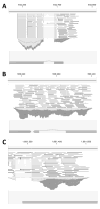Refined Pichia pastoris reference genome sequence
- PMID: 27084056
- PMCID: PMC5089815
- DOI: 10.1016/j.jbiotec.2016.04.023
Refined Pichia pastoris reference genome sequence
Abstract
Strains of the species Komagataella phaffii are the most frequently used "Pichia pastoris" strains employed for recombinant protein production as well as studies on peroxisome biogenesis, autophagy and secretory pathway analyses. Genome sequencing of several different P. pastoris strains has provided the foundation for understanding these cellular functions in recent genomics, transcriptomics and proteomics experiments. This experimentation has identified mistakes, gaps and incorrectly annotated open reading frames in the previously published draft genome sequences. Here, a refined reference genome is presented, generated with genome and transcriptome sequencing data from multiple P. pastoris strains. Twelve major sequence gaps from 20 to 6000 base pairs were closed and 5111 out of 5256 putative open reading frames were manually curated and confirmed by RNA-seq and published LC-MS/MS data, including the addition of new open reading frames (ORFs) and a reduction in the number of spliced genes from 797 to 571. One chromosomal fragment of 76kbp between two previous gaps on chromosome 1 and another 134kbp fragment at the end of chromosome 4, as well as several shorter fragments needed re-orientation. In total more than 500 positions in the genome have been corrected. This reference genome is presented with new chromosomal numbering, positioning ribosomal repeats at the distal ends of the four chromosomes, and includes predicted chromosomal centromeres as well as the sequence of two linear cytoplasmic plasmids of 13.1 and 9.5kbp found in some strains of P. pastoris.
Keywords: Centromere; Genome; Killer plasmid; P. pastoris; RNA-seq; Splicing.
Copyright © 2016. Published by Elsevier B.V.
Figures







References
-
- Banerjee H, Kopvak C, Curley D. Identification of Linear DNA Plasmids of the Yeast Pichia pastoris. Plasmid. 1998;40:58–60. - PubMed
-
- Banerjee H, Verma M. Search for a novel killer toxin in yeast Pichia pastoris. Plasmid. 2000;43:181–3. - PubMed
-
- Bevis BJ, Hammond AT, Reinke CA, Glick BS. De novo formation of transitional ER sites and Golgi structures in Pichia pastoris. Nat Cell Biol. 2002;4:750–756. - PubMed
Publication types
MeSH terms
Substances
Grants and funding
LinkOut - more resources
Full Text Sources
Other Literature Sources

